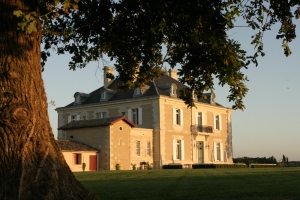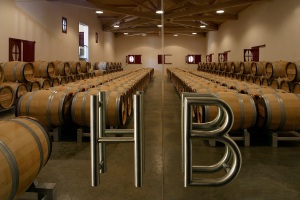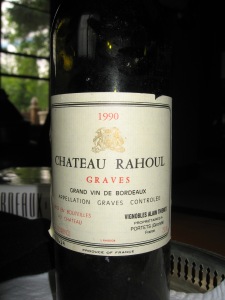Last week, at the National Club in downtown Toronto, I attended a tasting of 3 vintages (2006, 2007, 2008) of Chateau Haut-Bailly and its second wine La Parde de Haut-Bailly. The tasting was lead by the manager of the property, the lovely and passionate Veronique Sanders. (All photographs are courtesy of Chateau Haut-Bailly.)
 Chateau Haut-Bailly is located on the left bank of the Gironde in the Pessac -Leognan appellation, where the other 15 Graves Grand Cru Classes are also found. The only property from the Graves appellation included in the famous 1855 Bordeaux classification was Haut-Brion,(all the others were from the Medoc region) so in 1959, Graves came out with its own classification system. The 16 Chateaux named as Grand Cru Classe can be classified for either their red wine, their white wine, or both. Chateau Haut-Bailly only makes red wine.
Chateau Haut-Bailly is located on the left bank of the Gironde in the Pessac -Leognan appellation, where the other 15 Graves Grand Cru Classes are also found. The only property from the Graves appellation included in the famous 1855 Bordeaux classification was Haut-Brion,(all the others were from the Medoc region) so in 1959, Graves came out with its own classification system. The 16 Chateaux named as Grand Cru Classe can be classified for either their red wine, their white wine, or both. Chateau Haut-Bailly only makes red wine.
Chateau Haut-Bailly was founded in 1630 by a Parisian banker named Firmin Le Bailly and his partner Nicolas de Leuvarde. After Le Bailly’s death, his son Nicolas took over but eventually had to sell. The estate passed through several hands until 1872 when it was purchased by Alcide Henri Bellot des Minieres, who built the chateau and further developed the vineyards. Shortly afterwards, phylloxera struck. Bellot des Minieres refused to graft his vines onto American rootstocks, but instead chose to wash each vine in a copper-sulphate solution. Apparently there is still a 3 hectare parcel of ungrafted vines.
In the early 20th century, the wines of Haut-Bailly were so highly regarded that they commanded prices on par with the Bordeaux first growths. The property changed hands a few more times until 1955 when it was acquired by Daniel Sanders, a Belgian wine merchant from Barsac. By this time the estate had suffered years of neglect and the vineyards had been reduced from 36 hectares to only 10 hectares. Sanders began the huge task of restoring the property to its former glory. In 1998, Haut-Bailly was purchased by Robert G. Wilmers. They continued the task of improving the vineyards and winemaking facilities, and have completely restored the chateau. Today, the wines are among the most respected in Bordeaux, and the property is under the management of Veronique Sanders, the granddaughter of Daniel Sanders.
Bordeaux first growths. The property changed hands a few more times until 1955 when it was acquired by Daniel Sanders, a Belgian wine merchant from Barsac. By this time the estate had suffered years of neglect and the vineyards had been reduced from 36 hectares to only 10 hectares. Sanders began the huge task of restoring the property to its former glory. In 1998, Haut-Bailly was purchased by Robert G. Wilmers. They continued the task of improving the vineyards and winemaking facilities, and have completely restored the chateau. Today, the wines are among the most respected in Bordeaux, and the property is under the management of Veronique Sanders, the granddaughter of Daniel Sanders.
In 1967, the chateau introduced a second label called La Parde de Haut-Bailly. This is a ‘true’ second wine, as Veronique Sanders told the group last week. It is a ‘true’ second wine because the grapes are treated the same in the vineyard as the first wine, in fact most of the time they haven’t even been declassified yet. The grapes are then all vinified the same. After fermentation the selection process takes place. The wine for the first wine is selected first and then for the second wine. The remaining wine is then used for the third generic label. La Parde de Haut-Bailly is then aged in barrel for 12 months, compared to the 16 to 18 months for the first wine.
2008: The spring was cool and May was wet, causing problems with flowering which led to poor fruit set and uneven grape size. Rot was also a threat. Dry weather and ideal conditions returned in July only to disappear again in August. Great care was taken in the vineyards to ensure good aeration and prevent rot setting in. Veraison of the Merlots and Cabernets were about 2 weeks behind usual. Luckily, September and October were dry and beautiful, allowing the grapes to ripen to perfect maturity. The harvest was very late and very long, taking place over a period of 5 weeks. Overall, yields were low, and acidity remained fairly high. The grapes were smaller than normal, giving wines of real concentration.
2007: An early spring and warm April meant that flowering was about 3 weeks earlier than normal. High amounts of rain in May threatened the vineyards with mildew, calling for constant attention from vineyard workers. Cool, cloudy days continued throughout the summer. Fortunately, ideal weather returned in September and October giving sunny days and cool nights.
2006: The spring was one of the driest on record. Dry weather and high temperatures in June enabled good fruit set and an abundant crop. High heat in July interrupted growth but cooler temperatures in August helped to ripen the grapes. The good weather continued into September and the grapes ripened to perfect maturity.
Tasting Notes:
La Parde de Haut-Bailly AC Pessac-Leognan:
2008: The nose shows complex aromas of cedar, cassis, black raspberry, licorice, baking spice, and dark chocolate. Ripe fruit flavours and spice are supported by a firm structure – good acidity and lots of fine-grained tannins. This wine is concentrated and balanced and can probably age another 10 to 15 years. ($39)
2007: Slightly less intense than the 2008 with aromas of mineral, raspberry, violets, and cedar. Less concentrated on the palate, but still with lots of ripe fruit and mineral notes. ($29)
2006: This wine has very pretty aromatics of cedar, cherry, raspberry, mineral, black licorice and a floral perfume. The upfront silky texture gives way to some very firm tannins and flavours of dusty earth, red fruit, cedar, and dried leaves. This was my favourite of the 3.
Chateau Haut-Bailly AC Pessac-Leognan:
2008: Intense and complex aromas of ripe raspberries, cassis, and stoney minerals with an aromatic floral character. Very juicy on the palate with a silky texture and fine-grained tannins leading to a long finish. Concentrated and powerful. ($95)
2007: This wine is a blend of 70 % Cabernet Sauvignon, 26% Merlot, and 4% Cabernet Franc. Enticing aromas of cedar box, red licorice, plum, and ripe red berry aromas of cherry and raspberry. Not as concentrated as the 2008, but still supple and elegant. ($84) Just released on Feb 19, 2011 at the LCBO so there’s still quite a bit still available.
2006: No Cabernet Franc was used at all in this blend – only Cabernet Sauvignon and Merlot. Overflowing with wild berries, mineral, and cedar aromas with pretty floral notes. Firm, but fine-grained tannins build on the very silky texture. A long, luxurious finish. Silky and seductive. ($94) Released at the LCBO over a year ago, but there are still a few bottles left in the system.
A few of these wines are available through the LCBO or you can contact Noble Estates Wine and Spirits for more details.

